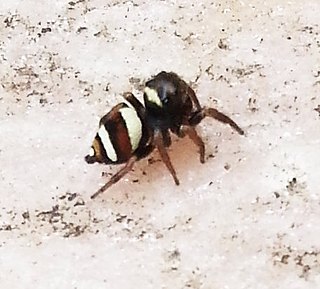
Myrmarachne is a genus of ant-mimicking jumping spiders that was first described by W. S. MacLeay in 1839. They are commonly called ant-mimicking spiders, but they are not the only spiders that have this attribute. The name is a combination of Ancient Greek μύρμηξ, meaning "ant", and ἀράχνη, meaning "spider".

Cosmophasis is a genus of spiders in the family Salticidae. They are predominantly Southeast Asian, while some species occur in Africa and Australia. Although most species more or less mimic ants, there are also colorful species that follow a different strategy.

Langona is a genus of spiders in the family Salticidae. Langona species are similar to those of the genus Aelurillus. In 2015, it was listed in the subtribe Aelurillina. The subtribe is allocated to the tribe Aelurillini in the clade Saltafresia. In 2017, it was grouped with nine other genera of jumping spiders under the name Aelurillines.

Pancorius is a genus of Asian jumping spiders that was first described by Eugène Louis Simon in 1902. They are similar to Hyllus.

Phintella is a genus of jumping spiders that was first described by W. Bösenberg & Embrik Strand in 1906.
Pristobaeus is a genus of jumping spiders that was first described by Eugène Louis Simon in 1902.

Ptocasius is a genus of Asian jumping spiders that was first described by Eugène Louis Simon in 1885.

Rhene is a spider genus of the family Salticidae.

Simaetha is a genus of Australasian jumping spiders that was first described by Tamerlan Thorell in 1881. They resemble members of Simaethula and Stertinius.

Synagelides is a genus of Asian jumping spiders that was first described by W. Bösenberg & Embrik Strand in 1906. This genus and Agorius are separated as a genus group, sometimes called subfamily Agoriinae, but more recently downranked to tribe Agoriini of the Salticoida clade in subfamily Salticinae.
Tauala is a genus of jumping spiders that was first described by F. R. Wanless in 1988. The name "Tauala" is an arbitrary combination of letters.

Telamonia is a genus of jumping spiders that was first described by Tamerlan Thorell in 1887. They are colorful spiders, with patterns that vary considerably between sexes and species. Two longitudinal stripes along the abdomen are common, and the carapace is often colored. They have a slender opisthosoma and long legs.

Thyene is a genus of jumping spiders that was first described by Eugène Louis Simon in 1885. It is a junior synonym of Mithion, and senior synonym of Brancus, Paramodunda and Gangus.

Viciria is a genus of jumping spiders that was first described by Tamerlan Thorell in 1877.

Cheiracanthium, commonly called yellow sac spiders, is a genus of araneomorph spiders in the family Cheiracanthiidae, and was first described by Carl Ludwig Koch in 1839. They are usually pale in colour, and have an abdomen that can range from yellow to beige. Both sexes range in size from 5 to 10 millimetres. They are unique among common house spiders because their tarsi do not point either outward, like members of Tegenaria, or inward, like members of Araneus), making them easier to identify.

Clubiona is a genus of sac spiders that was first described by Pierre André Latreille in 1804.

Cosmophasis thalassina is a species of jumping spider found from Malaysia to Australia. It was probably dispersed to the gardens and the parks of Queensland by man.

Wanda Wesołowska is a Polish zoologist known for her work with jumping spiders. She has described more species of jumping spider than any contemporary writer, and is second only to Eugène Simon in the history of arachnology. Originally a student of ornithology, she developed an interest in jumping spiders while still a student at the Siedlce University of Natural Sciences and Humanities in the 1970s.
Neaetha maxima is a species of jumping spider in the genus Neaetha that lives in Ivory Coast and Nigeria. It was first described in 2011 by Wanda Wesołowska & Anthony Russell-Smith based on a holotype found near Ibadan. Only the female has been described. The spider is atypically large, over 10 mm (0.39 in) long, which is reflected in the species name. The genus name can be translated new aspect. It has a light brown carapace and yellow-white abdomen, with orange-brown legs. The epigyne has a distinctive central pocket and wide copulatory ducts.

















